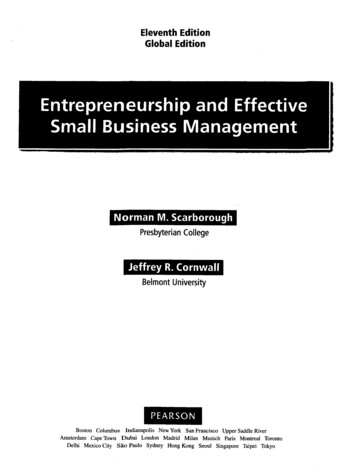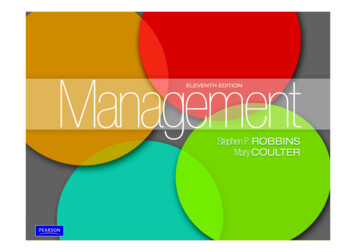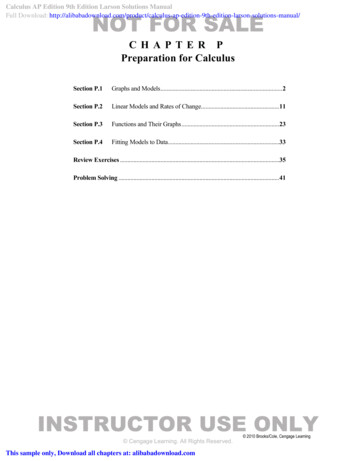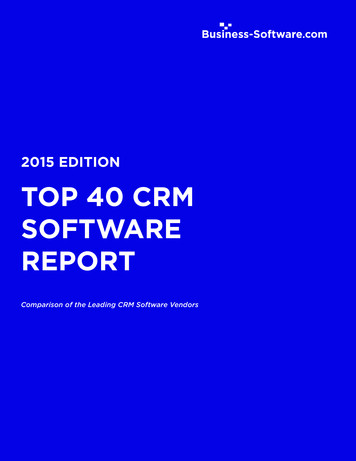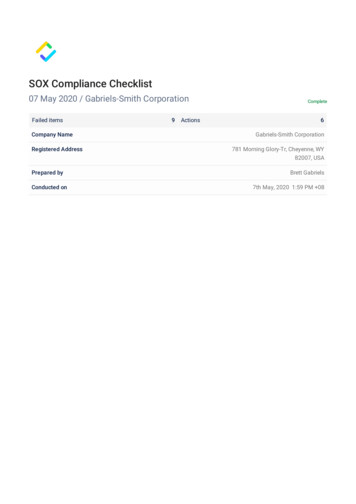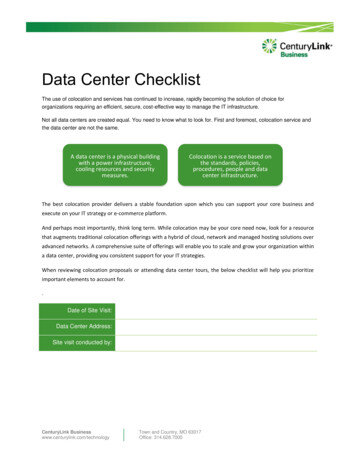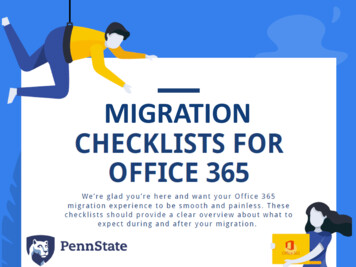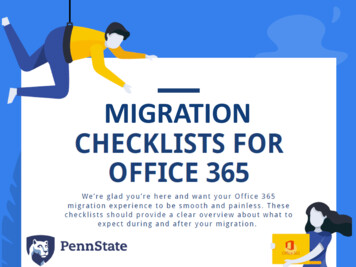
Transcription
SQF EDITION 8 - CHECKLIST1.Does your management responsibility procedure state that seniormanagement will ensure that all training required to meet the SQFCode will be fully provided? (2.1.2.6)2.Are staff fully aware of their responsibilities – can you prove thisthrough things like job descriptions or other documented means? (2.1.2.7)3.Do senior management have a plan as to how they are going to ensure the integrity andcontinued compliance to the SQF Code, in a situation where there is a lack of resource, or achange in personnel? E.g. agreed deputies who have adequate capability to ‘step-up’? (2.1.2.10)4.Have you provided the certification body with defined blackout periods for unannounced audits?(2.1.2.11)5.Does your SQF practitioner have a monthly (as a minimum) update meeting with seniormanagement, to update them on compliance matters? And, are the updates and responsesdocumented? (2.1.3.2)6.Are all management reviews documented? (2.1.3.4)7.Have you re-titled your business continuity plan to crisis management plan? (2.1.5)8.Does the crisis management plan cover all crisis situations which may put the site ability to deliversafe food at risk? (2.1.5.1)9.Have you updated your crisis contact list to include supply-chain customers? (2.1.5.2vi)10.Do you know which legislation is applicable to both the country of manufacturer of your products,and the country in which they will be consumed? Can you provide copies of this legislation? Canthe person who interprets this legislation, talk confidently about the requirements of thelegislation, to provide evidence of competence? (2.3.2.2, 2.4.1.1)11.Is the SQF requirement to inform them of regulatory warnings (within 24 hours), plus the emailaddress (foodsafetycrisis@sqfi.com) written into your food safety system? (2.4.1.3)12.Where you have exemptions to the Code, have these been justified and proven (where possible)in a written risk analysis? (2.4.2.1)13.Do you have a multi-disciplinary HACCP team, covering technical, production, engineering andother relevant departments? (2.4.3.3)14.Do you have a scope for each product in your HACCP? (2.4.3.4)15.Do you have a product description for each product in your HACCP? Does it cover the foodsafety intrinsics of the product? (2.4.3.5)16.Have you defined the intended use and intended user for your products in your HACCP? (2.4.3.6)17.Do you have a process flow diagram that covers all product in your HACCP? (2.4.3.7)18.Does the process flow diagram cover all ingredients, packaging items, service inputs, waste,rework and process delays? (2.4.3.7)19.Has your process flow diagram been confirmed by the HACCP team to be accurate (accurateduring all hours of operation), by signing it and dating it? (2.4.3.7)1 Page Kassy Marsh: Techni-K Consulting Ltd
SQF EDITION 8 - CHECKLIST20.Have you identified and documented all the relevant hazards for eachprocess step in your flow diagram? (2.4.3.8)21.Have each of these hazards been analyzed to establish which hazardsare significant? (2.4.3.9)22.Do you have a documented method for deciding how significance will be determined? (2.4.3.9)23.Has the method for determining significance been used consistently throughout the HACCP?(2.4.3.9)24.Do the critical limits applied to CCP’s, clearly show the point at which the product becomes safe?(2.4.3.12)25.Does each CCP have a monitoring procedure which clearly states the corrective action in theevent of a failure? (2.4.3.13, 2.4.3.14)26.Has a full HACCP review been completed within the last 12 months? (2.4.3.15)27.Have any changes occurred in the last 12 months that should have instigated a review? Was itdone? (2.4.3.15)28.Have all the relevant legislations and guidelines for the country of manufacturer and the countryof sale (to the consumer) been referenced in the HACCP? (2.4.3.17)29.Are there specifications in place for all ingredients, packaging and (food safety related) services?(2.4.4.1)30.Are non-approved suppliers only used in emergency situations (i.e. not routinely)? (2.4.4.2)31.Are materials from non-approved suppliers, in emergency situations, inspected or tested beforeuse? And, is this documented in the procedure? (2.4.4.2)32.Do you have a documented procedure for the selection, evaluation, approval and monitoring ofsuppliers? (2.4.4.3)33.Is the approved supplier program (as written in the procedure) applied to all internally suppliedmaterials as well? (2.4.4.7)34.Does the procedure state how the supplier risk analysis will be completed, to determine the auditfrequency? (2.4.4.9)35.Has this risk assessment been carried out on all suppliers and have the audits been completed asper the result? (2.4.4.9)36.Is reworking of ingredients, packaging and product covered in the documented reworkprocedure? (2.4.6.1)37.Has a documented risk analysis been carried out to establish what environmental monitoring isneeded? (2.4.8.1)38.Is there a documented environmental monitoring procedure, which details responsibilities,methods of testing and how the risk assessment is to be completed? (2.4.8.2)39.Is there a documented sampling and testing program, detailing the tests, the number of samplesand frequency of sampling? (2.4.8.3)2 Page Kassy Marsh: Techni-K Consulting Ltd
SQF EDITION 8 - CHECKLIST40.Are the results of environmental monitoring reviewed on receipt, andwhere they are out of spec, are corrective actions put in place?(2.4.8.4)41.Are the results also trended and then reviewed for trends? (2.4.8.4)42.Are legal elements of the system verified? E.g. are legal criteria monitored? Is equipment usedfor legal checks verified for accuracy? Are legal requirements included in the internal auditsystem? (2.5.2.2)43.Do your corrective action records detail the original non-conformity? (2.5.3.2)44.If environmental or product testing is carried out on site, do you carry out proficiency (ring) testingto prove that the results are accurate and consistent? (2.5.4.2)45.If you use an external lab, do you have a service contract with them that states that they must beaccredited to ISO 17025 or equivalent? (2.5.4.3)46.Are all of your internal audits carried out at least annually? (2.5.5.1)47.Does your internal audit system, cover all elements of the SQF Code? (2.5.5.1)48.Do you carry out GMP audits on a regular basis? (2.5.5.3)49.Are these GMP audits recorded, including corrective actions? (2.5.5.3)50.Is there a documented start-up and change over procedure in place for making sure that the rightproduct goes in the right packaging? (2.6.1.3)51.Is this recorded and then inspected and approved by an authorized person? (2.6.1.3)52.Is the traceability test carried out as part of the product recall and withdrawal test (and has it beendone in the last 12 months)? (2.6.2.1)53.Does your withdrawal and recall procedure detail sources of regulatory advice to be used?(2.6.2.1)54.Does it also state the not only will the SQFI be informed in such an event, but also the appropriateregulatory authorities? (2.6.2.1)55.Are the results of mock recalls reviewed (and documented) and where failures in the system arefound, are corrective actions to root cause put in place? (2.6.3.2)56.Is the recall test carried out back one step to the manufacturing supplier (not an agent) andforward to the next product destination? (2.6.3.3)57.Does the recall procedure include the notification details for SQFI? (2.6.3.4)58.Does the food defense plan cover ingredients, packaging, work-in-progress materials andprocess inputs? (2.7.1.2)59.Has a recorded review been carried out of the food defense plan in the last 12 months? (2.7.1.3,2.7.1.4)60.Have you created a food fraud vulnerability assessment? (2.7.2.1)3 Page Kassy Marsh: Techni-K Consulting Ltd
SQF EDITION 8 - CHECKLIST61.Do you have and have you implemented a mitigation plan for anyhighlighted food fraud threats? (2.7.2.2)62.Has the food fraud vulnerability assessment and mitigation plan beenreviewed (documented) in the last 12 months? (2.7.2.3, 2.7.2.4)63.Does your allergen management system cover allergens from workplace-related areas? (2.8.1.1ii)64.Does the plan cover gluten? (2.8.1.1)65.Are there documented instructions for personnel which detail the required allergen receipt andhandling activities? (2.8.1.2)66.Are there documented segregation procedures for allergens? (2.8.1.3)67.Is there documented evidence to prove that cleaning to remove cross-contact of allergens iseffective? (2.8.1.4)68.Where cleaning cannot be carried out effectively to control allergen cross-contact, is separateequipment used? (2.8.1.4)69.Are changeover procedures in place that cover allergen control? (2.8.1.6)70.Are there documented methods in place for ensuring that label information is accurate? E.g.artwork sign off or on-site label printing checks? (2.8.1.8)71.Do changeover procedures cover the control of labels, such as reconciliation and destruction ofunneeded labels? (2.8.1.11)72.Are instructions (and procedures) provided to personnel in the relevant language? (2.9.3.1)73.Are overheads constructed in a manner where they do not pose a risk of contamination (e.g. noloose or hanging parts)? (11.2.3.3)74.Do you have waste pipes directly over ingredients, packaging, product, or food contact surfaces?If so, are these designed so that they do not pose a risk to the product? (11.2.3.4)75.Do you have stairs, catwalks or platforms in food areas? Do these have open grates in them?(11.2.4.1)76.Do inspection/quality control areas have appropriate waste handling and removal, and are theykept clean? (11.2.6.2)77.Are your ventilation equipment and devices on your cleaning schedule? (11.2.8.2)78.Do you have specification for all equipment, utensils and protective clothing that is in use?(11.2.9.1)79.Do you have a documented procedure for how these items are to be purchased/ assessedbefore purchase? (11.2.9.1)80.Are pieces of equipment, utensils and protective clothing cleaned after each use, or at a setfrequency defined to control contamination? (11.2.9.8)81.Are contractors and visitors escorted at all times, unless they have been formally trained in thesites hygiene procedures? (11.2.10.5, 11.3.5.5)4 Page Kassy Marsh: Techni-K Consulting Ltd
SQF EDITION 8 - CHECKLIST82.Do you have a procedure which controls temporary repairs?(11.2.10.8)83.Is a pre-operational inspection carried out prior to re-starting of theprocess, following maintenance? (11.2.10.9)84.Do you use software for calibration? Has it been validated? (11.2.11.1)85.Does your pest prevention system (or contractor) carry out an assessment of the risk toingredients, packaging and product, where pest activity is highlighted? Is this recorded, withactions taken? (11.2.12.2)86.Where pest activity is highlighted, are records kept of the investigations, treatments andresolution? (11.2.12.3)87.Are records kept of pest sightings? (11.2.12.4ii)88.Are pest trends reviewed to target pesticide applications? (11.2.12.4ii)89.If you have a CIP system, has the equipment and the parameters been validated? (11.2.13.4)90.Is the CIP equipment on the maintenance schedule, including checking of spray balls? (11.2.13.4)91.Is there a documented procedure for modifications to the CIP system, including software andsettings changes? (11.2.13.4)92.Have personnel had suitable CIP training? (11.2.13.4)93.Are CIP parameters routinely monitored? (11.2.13.4)94.Are all cleaning activities inspected by a qualified person? (11.2.13.5, 11.2.13.6)95.Do you have a list of approved chemicals? (11.2.13.8i)96.Are recorded chemical strength checks in place? (11.2.13.9)97.Are chemical solutions stored in suitable containers which are clearly labeled? (11.2.13.9)98.Are there controls in place to stop wounds, coughing, sneezing, spitting etc. from contaminatingthe product? (11.3.1.2)99.Do you have a bodily fluids procedure? (11.3.1.2)100. Have you completed a risk analysis for what protective clothing, including hair protection isrequired?101. If personnel can keep their food use aprons and gloves in their locker, are they provided with asuitable, clean, sealed container to keep them in? (11.3.3.5)102. Medical alert bracelets are only allowed if they have been prescribed. Check to make sureanybody with one, has had it prescribed to them. (11.3.4.1)103. Do toilet rooms have somewhere inside or nearby for personnel to leave protective clothing,outer garments and other items while using the facilities? (11.3.9.1v)104. If you provide outside eating areas, are they kept clean? (11.3.10.3)5 Page Kassy Marsh: Techni-K Consulting Ltd
SQF EDITION 8 - CHECKLIST105. If you provide outside eating areas, do you have a sign up in this areato say that personnel should wash their hands before entering theprocessing area? (11.3.10.4)106. Do personnel procedures state that false eyelashes, eyelash extensions and long nails are notpermitted? (11.4.1.1vi)107. Do personnel procedures state that hair restraints must be used in areas where the product isexposed? (11.4.1.1vii)108. Are hoses, taps or other water outlets designed so that they do not allow back flow? (11.5.1.4)109. Is water storage equipment, designed, constructed and maintained so that it preventscontamination? (11.5.1.5)110. Has treated water, used as an ingredient or for food contact purposes, been tested in the last 12months? (11.5.2.4)111. Are all water outlets which are used for ingredient water or foods contact purposes, on thesampling plan for testing? (11.5.4.2)112. Do you have a risk analysis to show if annual water testing is sufficient or not? (11.5.4.2)113. If you use food contact gases, is the gas and the delivery equipment tested to prove that it issafe? (11.5.5.2)114. Do you have a storage plan (map) that shows the storage areas? (11.6.1.1)115. Do you have a procedure which controls the shelf life of rework? (11.6.1.3)116. Where pest prevention chemicals are decanted, are they stored in clearly labeled and suitablecontainers, that meet the legislation? (11.6.4.4)117. Do you use any storage measures that are not
SQF EDITION 8 - CHECKLIST 1. Does your management responsibility procedure state that senior management will ensure that all training required to meet the SQF Code will be fully provided? (2.1.2.6) 2. Are staff fully aware of their responsibilities – can you prove this through things like job descriptions or other documented means? (2.1.2.7) 3. Do senior management have a plan as to how they are going

